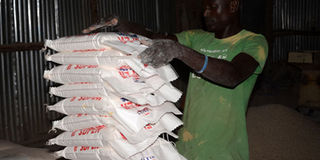It’s time to think about handling maize harvest

A worker at Kiryandongo Produce Buyers and Dealers Association stacks bags of maize flour. PHOTO BY GEORGE KATONGOLE.
What you need to know:
- Harvest time normally comes early for farmers yet for some, there is shortage of options to keep the maize longer. These challenges can be handled with prior planning, writes by George Katongole.
Nothing dominates Uganda’s harvest season like coffee and maize.
Smallholder farms sprawling across the country make maize production a massive activity.
Maize is a versatile crop that grows nearly anywhere in the country, especially, Iganga, the largest producer as well as Mubende, Soroti, Kabarole, Masaka, Kamuli, Tororo, Bugiri, Masindi and Kibaale districts.
The main reason why so much maize is grown is the increasing consumption among poor households. Value addition is still low in Uganda, making flour the most common product from the maize. But it is important in animal feed production of piggery, chicken and cattle.
While ethanol production is increasingly the focus of the global maize industry, there was no evidence uncovered during field research that Ugandan maize was being used for fuel production.
The current harvest season is a welcome period for farmers as some financial challenges can be solved, but emphasis on post-handling need to be observed. Post-harvest losses account for about 30 per cent of the harvested maize, according to a Gates Foundation report of 2014.
Harvest time
Instabilities in Uganda’s main markets of South Sudan as well as Rwanda and Burundi, call for better post-harvest procedures. In December, the farm gate prices were at Shs850 per kilo but have started dwindling.
According to Milly Nanyondo, a mill operator in Kiganda, Mubende District, the current prices are Shs750 per kilo and she expects them to drop further when more harvests start coming in.
“At the moment the mill is idle because we do not have enough supply but we shall resume operations at the end of January,” Nanyondo says.
According to Kigumba Produce Buyers and Dealers Association (KPBDA), post-harvest handling is one of the main initiatives of the association as they attempt to to help farmers minimise post-harvest losses and ostensibly increase their income levels.
According to Christopher Waiswa, the secretary to the association, farmers should not rush to sell their produce at the peak of the harvest.
“It is important to make the produce more valuable,” Waiswa says. Post-harvest goes through a number of stages including harvesting, transportation, drying, threshing/sorting, cleaning, storage, processing, packaging and marketing.
Maize post-harvest handling is an important because farmers can experience losses if not handled technically right.
Sam Kakumba, the Kiryandongo Distrcit Commercial Officer notes that the export market is critical for Ugandan farmers. “Farmers need to seek export opportunities to earn from their produce,” Kakumba explained.
Kenya is the most significant market destination accounting for at least 50 per cent of total exports in the previous years.
Best practices
Waiswa stresses that during harvesting ready, maize should be harvested to avoid shrinkage something that greatly reduces weight and quality of maize kernels.
Proper drying of the harvest needs to be observed.
Waiswa explains that maize should not be dried on bare ground as this compromises the quality through contamination with soil and other foreign matter. Free range animals can also contaminate the maize.
During threshing, maize losses occur as a result of using sticks to beat maize that leads to broken kernels which reduces maize grade and quality.
After drying, losses should be avoided by storing maize with the recommended moisture content which is above 13 per cent. High moisture content causes development fungi (mould) which is considered cancerous, making it unfit for human consumption.
Hermetic storage technology is an alternative method that minimises post-harvest losses by depleting oxygen and increasing carbon dioxide levels within the storage container.
A simple way to test moisture
Many farmers may be unprepared for the harvest season. It is very difficult for farmers to attain the recommended moisture level of 13.5 per cent. Besides, most of the people in rural areas may not be able acquire a moisture meter to check moisture levels during storage. Farmers can use of an empty soda bottle and some salt.
After drying, put a handful of maize grains and a half handful of table salt in dry soda bottle. Shake the bottle for two to three minutes. Allow the grains to settle. If the salt sticks onto the walls of the bottle, this is a sign that the maize has not dried well enough for storage.




